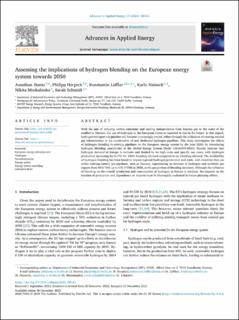| dc.contributor.author | Hanto, Jonathan | |
| dc.contributor.author | Herpich, Philipp | |
| dc.contributor.author | Löffler, Konstantin Emanuel | |
| dc.contributor.author | Hainsch, Karlo | |
| dc.contributor.author | Moskalenko, Nikita | |
| dc.contributor.author | Schmidt, Sarah Yvonne | |
| dc.date.accessioned | 2024-04-05T10:37:29Z | |
| dc.date.available | 2024-04-05T10:37:29Z | |
| dc.date.created | 2024-01-22T13:53:02Z | |
| dc.date.issued | 2023 | |
| dc.identifier.citation | Advances in Applied Energy. 2023, 13 . | en_US |
| dc.identifier.issn | 2666-7924 | |
| dc.identifier.uri | https://hdl.handle.net/11250/3125051 | |
| dc.description.abstract | With the aim of reducing carbon emissions and seeking independence from Russian gas in the wake of the conflict in Ukraine, the use of hydrogen in the European Union is expected to rise in the future. In this regard, hydrogen transport via pipeline will become increasingly crucial, either through the utilization of existing natural gas infrastructure or the construction of new dedicated hydrogen pipelines. This study investigates the effects of hydrogen blending in existing pipelines on the European energy system by the year 2050, by introducing hydrogen blending sensitivities to the Global Energy System Model (GENeSYS-MOD). Results indicate that hydrogen demand in Europe is inelastic and limited by its high costs and specific use cases, with hydrogen production increasing by 0.17% for 100%-blending allowed compared to no blending allowed. The availability of hydrogen blending has been found to impact regional hydrogen production and trade, with countries that can utilize existing natural gas pipelines, such as Norway, experiencing an increase in hydrogen and synthetic gas exports from 44.0 TWh up to 105.9 TWh in 2050, as the proportion of blending increases. Although the influence of blending on the overall production and consumption of hydrogen in Europe is minimal, the impacts on the location of production and dependence on imports must be thoroughly evaluated in future planning efforts. | en_US |
| dc.language.iso | eng | en_US |
| dc.publisher | Elsevier | en_US |
| dc.rights | Navngivelse 4.0 Internasjonal | * |
| dc.rights.uri | http://creativecommons.org/licenses/by/4.0/deed.no | * |
| dc.title | Assessing the implications of hydrogen blending on the European energy system towards 2050 | en_US |
| dc.title.alternative | Assessing the implications of hydrogen blending on the European energy system towards 2050 | en_US |
| dc.type | Journal article | en_US |
| dc.type | Peer reviewed | en_US |
| dc.description.version | publishedVersion | en_US |
| dc.source.pagenumber | 1-16 | en_US |
| dc.source.volume | 13 | en_US |
| dc.source.journal | Advances in Applied Energy | en_US |
| dc.identifier.doi | 10.1016/j.adapen.2023.100161 | |
| dc.identifier.cristin | 2231995 | |
| cristin.ispublished | true | |
| cristin.fulltext | original | |
| cristin.qualitycode | 1 | |

